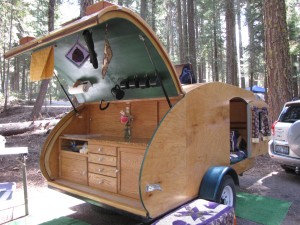This pic shows the ice chest on its shelf. My ice chest has a cooler cozy quilt to extend the ice life. .
Oh and big doors! Big doors are very important.
Teardrop - Form versus Function
28 posts
• Page 2 of 2 • 1, 2
Re: Teardrop - Form versus Function
Debbie (with Randy looking over my shoulder)
Our build thread: http://www.tnttt.com/viewtopic.php?t=41295&highlight=monstero
2009 Homebuilt woody, Kenskill inspired 5 wide


Our build thread: http://www.tnttt.com/viewtopic.php?t=41295&highlight=monstero
2009 Homebuilt woody, Kenskill inspired 5 wide

-

nevadatear - Silver Donating Member
- Posts: 2381
- Images: 171
- Joined: Mon Nov 10, 2008 2:37 pm
- Location: No. Nevada
Re: Teardrop - Form versus Function
Strop wrote:Hi all,
I can see some of the limitations with a teardrop choice:
kitchen access in bad weather
~~~~~~~~~~~~~~~~~~~~~~~~~~~~~~~~~~~~~~~~~~~~~~~~~~~~~~~~~~~~~~~~~~~~~~~~~
Dressing / undressing room
~~~~~~~~~~~~~~~~~~~~~~~~~~~~~~~~~~~~~~~~~~~~~~~~~~~~~~~~~~~~~~~~~~~~
Seating
~~~~~~~~~~~~~~~~~~~~~~~~~~~~~~~~~~~~~~~~~~~~~~~~~~~~~~~~~~~~~~~~~~~~~~~
Storage front cabinets
~~~~~~~~~~~~~~~~~~~~~~~~~~~~~~~~~~~~~~~~~~~~~~~~~~~~~~~~~~~~~~~~~~~~~~~~~~~
Limited space for tall people (I am 6' 2" +)
5x10 trailer with 8' from galley wall to front wall with 15" toe room under cabinets.
This sleeping configeration is a bit different but worked great with front cabinets.
~~~~~~~~~~~~~~~~~~~~~~~~~~~~~~~~~~~~~~~~~~~~~~~~~~~~~~~~~~~~~~~~~~~~~~~~~~~
Claustrophobic
see below
~~~~~~~~~~~~~~~~~~~~~~~~~~~~~~~~~~~~~~~~~~~~~~~~~~~~~~
Toilets
~~~~~~~~~~~~~~~~~~~~~~~~~~~~~~~~~~~~~~~~~~~~~~~~~~~~~~~~~~~~~~~~~~~~~~~~~~~
Any assistance here much appreciated.

Laurie
The cubby profile was my plan but it seemed to morf into the now infamous "Chubby" This was my first full size build.
And I can say that a First up pop up gazebo has solved each and every problem above except claustrophobia. ( for that I added a clear roof )
There are no limitations with a good imagination !
You can even get 9 feet of counter space in a five wide teardrop

Last edited by bobhenry on Mon May 20, 2013 8:31 am, edited 4 times in total.
Growing older but not up !
-

bobhenry - Ten Grand Club

- Posts: 10368
- Images: 2623
- Joined: Fri Feb 09, 2007 7:49 am
- Location: INDIANA, LINDEN
 Fred
Fred 